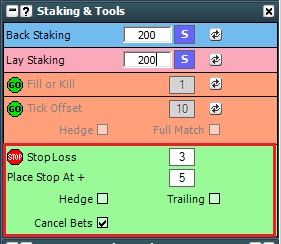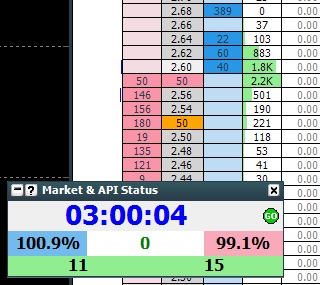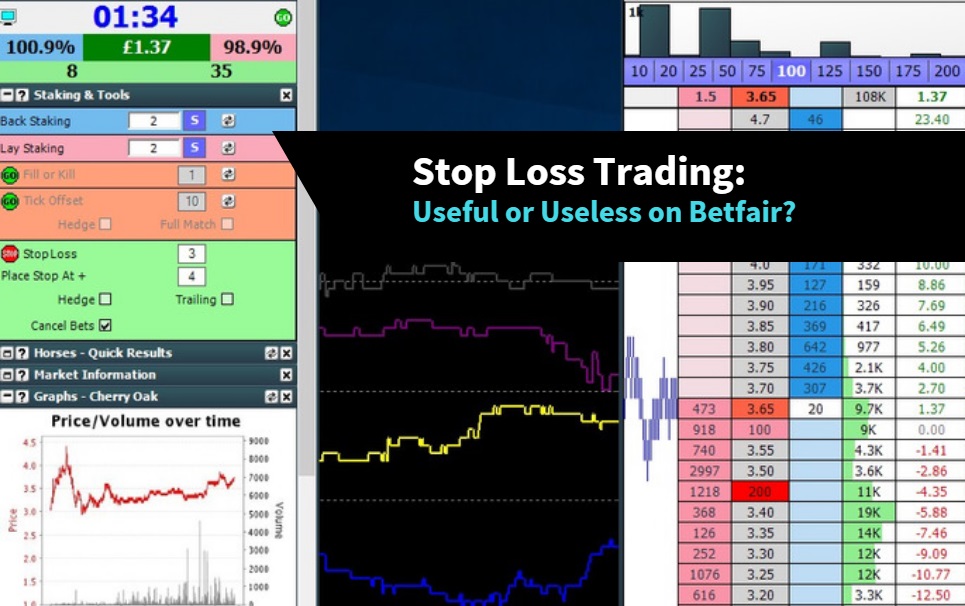Do you use stop-loss orders when trading Betfair? Should you?
Let’s take a look at what stop loss orders are, how they work and if they’re of much use.
In most cases, the final answer to the previous question is likely to depend on what you’re trading, and when…
What’s a Stop Loss?
As the name suggests, a stop loss order is placed in conjunction with an existing trade; the idea being that the trade is automatically closed when the market reaches a specific price, stopping out any potential loss. If you use one of the main Betfair trading software’s, you will have noticed they all possess the function to place a stop loss. Shown below via the Geeks Toy trading software.

The process is simple; A user places their opening trade. Once the bet is matched, you’re offered the option to stop out at a specific price. Usually several ticks away from the price your initial bet was matched. Another option, if you choose, is a trailing stop loss; meaning that the stop loss will follow your position with the market as it moves in your favour.
If you look at the image above the stop loss function is active. The trigger is set at 3 ticks (price increments) from our initial bet, with the counter order placed at 5 ticks.
Should the user tick the ‘trailing’ box, the software will automatically track the market activity and trigger at price reversal. The hedge tick box is just an option to hedge your market position at the triggered price.
The concept of using stop loss orders comes from other types of financial trading. The idea being that stop loss orders take the emotion out of making a trading decision, but seeing they were designed for other financial markets are they really of any use within Betfair Trading?
Stop Losses in Betfair Trading:
The answer to this question depends on what you are trading, as no two situations are created the same. If you are trading football matches, or pre-race hours before the start, then there is more chance that a stop loss order will be of use.
If you’re trading horse racing within the final couple of minutes, it’s not going to be so helpful. But why is that?
There are several elements to consider. Firstly, Betfair markets are time sensitive. Unlike the stock market, the event will go in play and finish with the market being closed forever.
Secondly, the markets are prone to being extremely volatile, depending on the situation. For stop loss traders, this is a massive problem. If you consider a horse race prior to the stop, just one or two large bets could trigger your stop loss, closing you out for a negative result when there may not have necessarily been anything wrong with your trade. Similarly, if you are to use a stop loss in play, there is no guarantee that your order will actually be matched. Because of the way a stop loss works, it means once a price is met, the order will be triggered into the market. However, if the market is that fast moving and volatile, you may find the closing order was never matched.
In short, the use of stop loss orders isn’t helpful over the short-term.

On the plus side, you could see a use for stop loss orders within longer term trading. Highly liquid situations may also be a better idea, such as football betting markets between the morning and afternoon. Beyond this use, I’m not particularly a fan of stop loss orders on Betfair.
In my opinion, it’s likely that the ‘tick offset’ feature is likely to be more use than a stop loss…
Tick Offset More Effective?
Although similar in the way they function, tick offset is the complete opposite. It’s where you place a trade, and the software closes out your position once a positive amount of ticks are made.
For example, if we were to place a trade of 4.0 with a tick offset of two, as soon as the price met (4.2) the software would trigger a closing trade into the market.
Much like stop loss orders, there’s the problem of not getting your bet matched once it’s triggered. However, I am aware of various traders that have made good use of the tick offset; mainly through speed and discipline advantages.
One guy used to post on the Geeks Toy forum named Wagonmaster General. There was no secret to his strategy. He would target horse races where horses traded extremely low within running and place a lay bet in the market early. Offering minimal liability was ideal, although as soon as the bet was matched, in the most frantic and volatile point of a race – a counter bet would be triggered. In competitive finishes both bets would be triggered in the blink of an eye for a quick profit. Sometimes the back bet would be matched at a far larger price than the offset had asked for!
The downside being; if the horse went onto win without the market bouncing any further, the liability on offer was lost. You have to remember liability is only small at those prices though. On the plus side, the erratic bounces within the market offered extreme value when matched. This was some time ago before the cross matching algorithm come to the fore, I suspect it’s less useful now. However, it’s interesting and useful to know…
If you aren’t familiar with cross-matching, there’s a full explanation about how it works here.


2 thoughts on “Stop Loss Trading: Useful or Useless on Betfair?”
Useless for in running trading as the market moves to quick. If you think outside the box very useful when trading pre race as people are like sheep they will always have a 4 to 6 tick stop loss so that in mind you should be looking to enter a trade 6 to 10 outside the trading range as when you catch a lucky spike it more often than not will bonce back for a quick green
Fantastic! Thanks for tagging into a twitter post. I tried this on the geek’s toy practice mode and got frustrated with the tool. This has helped fill in the gap of knowledge!